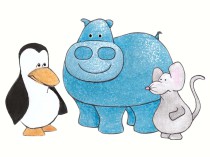Articulation Activities
Paperclip Pick-up: Attach paperclips to several of the child’s practice word cards, and set the cards out on a table. To target rhyming, you may say “Find a word that rhymes with…”, and let the child use a magnet wand or magnetic “fishing” tool to pick up the correct card and say the practice word. For expressive rhyming practice, you may let the child pick up a card of his/her choosing, practice producing the word, and then have the child provide a rhyming word.
Lights Out: Place several word cards on a table, floor, or around the room. You may use this activity to target identification of initial sounds, by saying “find a word that begins with…” Then turn out the lights and use a flashlight to help the child scale the table/room for words that begin with that sound. You may also choose to use the activity to target expressive alliteration skills by letting the child find a card of his/her choosing, practice production of the word, then ask the child to provide as many words as he/she can think of that begin with the same sound.
Magic Magnet: For this activity you can utilize a magnet wand or magnetic “fishing” tool and metallic chips (as found in many speech therapy materials), or simply use large paperclips. Practice segmenting at the sentence, syllable, or phoneme level by using the metallic chips to represent each part. For example, have the child practice the target word. Then help the child to create a short sentence using the target word. Count out the number of words in the sentence, and line up the same number of chips in front of the child on a table. Have the child point to each chip from left to right as you slowly say the words of the sentence. Then let the child use the magnet wand to pick up all the chips in the row from left to right as you say the sentence together. For more of a challenge, use this activity to practice deletion of the last word of the sentence by taking away a chip, or use the activity to target segmenting, blending, and deletion at the syllable or phoneme level.
Beanbag Toss: Set out a bucket and a few beanbags or small balls. Using the practice word cards, help the child say each word and identify the number of sounds/phonemes within the word. Based on the number of sounds within the word, the child will get to toss that many bags/balls into the bucket. Once complete, have the child say the whole word at the end. For example, if targeting the word moon, help the child to segment the phonemes m-oo-n. Allow the child to toss three bags/balls into the bucket while you help the child to again segment the word into m-oo-n (3 phonemes = 3 balls to throw). End with the child blending the sounds back together to produce the whole word.
Articulation & Language Activities
I Spy: Set out several word cards for the child’s target sound on a table or the floor. Use the activity to target descriptive language and listening skills by having the child describe one of the cards “I spy...” and then have the other children or yourself guess the correct response. You can then target identification of initial sounds by writing the initial sounds on a board with a ledge beneath or simply on a piece of paper set out on the table. Have the child place the chosen word card beneath the correct letter on the board ledge or on the piece of paper with the correct initial letter (for example- if targeting various s-blends, the child who guesses correctly for "snowman" would place the picture card under Sn, spoon would go under Sp, etc.).
Naming Game: Begin this activity by helping the child to write out his/her sound on a piece of paper. Next, you may address convergent or divergent naming skills by naming several items and asking the child to provide the correct category, or by giving the child a category and having him/her list several items. Use this task to target sound identification and auditory discrimination by instructing the child to raise his/her letter when the target sound is said. This activity is great for articulation carry-over and building self-awareness as well as developing understanding of category concepts and rapid naming.
Bag of Objects: Place several objects that contain the target sound inside a canvas bag. Also set out 2-3 buckets with a piece of paper taped to the front. You can use the buckets to show the location of the target sound in the word. For example if the target sound is /p/, on the first bucket write P____. On the second write ___p___, and on the third write ____p. Use the activity to address descriptive language by having the child pick out an item from the bag and describe it, or have the child pick out two items and tell how they are similar/different. Then help the child to place their object in the correct bucket based on the location of the sound in the word. Articulation carry-over across word positions will be targeted throughout the activity.
Goin’ on a Card Hunt: Set out several target word cards in various spots around the room. Use the activity to address spatial concepts by letting the child find a card, practice producing the word, and then state where the card was found (under the chair, between the books, inside the drawer, etc.). Incorporate rhyming practice by asking the child to provide a rhyming word for the found card. You may also choose to target identification of where the sound is located in the word by using the bucket method as described above in the Bag of Objects activity.

